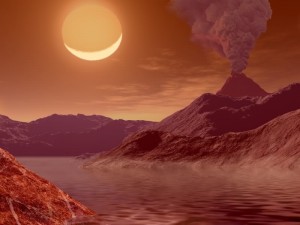
The primeval earth and smoggy sky with an enormous crescent moon at twilight as they may have appeared a mere billion years after formation.
Read an old astronomy text and you might see mention of a Goldilocks zone, the distance between the earth and sun, where the blessed earth is not too hot and not too cold. More recent work has shown this is a modern day fairy tale, the early earth was actually too far away. By rights the oceans should have been solid ice, the earth a lifeless, barren snowball. But it wasn’t. A new study confirms one big reason why the earth stayed so unseasonably warm early on:
(The Register) — According to Zerkle and his colleagues, during the period 2.5 to 2.65 billion years ago, microbes were already producing oxygen in the oceans. However very little of this made it into the nitrogen atmosphere; instead there was a fluctuating haze of hydrocarbons, mainly methane (aka natural gas) but with some ethane and propane (patio gas) mixed in. This is similar to the present-day atmosphere on Titan … Methane is still considered an important atmospheric gas by climate scientists today, as it has a greenhouse effect many times more powerful than carbon dioxide.
And, when methane and its various chemical cousins break down, they usually form carbon dioxide and water vapor. Two more potent greenhouses gases. As a result, the early earth was much warmer than it would have otherwise been.
Lucky for us!
Due to the vagaries of the fusion cycle powering the sun, our primeval star was smaller and dimmer than it is today. It increases in luminosity roughly 10% every billion years. If not for the methane smog and its heat trapping properties, our planet would have frozen as soon as it cool off after formation and heavy bombardment, and life would have been very different, if it lasted at all.
In point of fact, not longer after that period the green slime already quickening in earth’s oceans succeeded in poisoning the air with toxic oxygen. The change in chemistry and shift in biomass greatly reduced the concentrations of greenhouses gases. This may have played abig role in what happened next: our planet plunged into a series of the worst ice ages in the fossil record, at times some of them may have encompassed the entire planet right down to the equator. If not for greenhouses gases produced by volcanoes building up in the air during times of peak glaciation, we would have been stuck in that condition forever, or at least until the sun grew bigger and brighter and broke the world free of its self-imposed, icy embrace.

Leave a Reply
You must be logged in to post a comment.